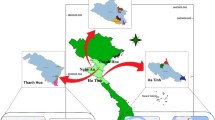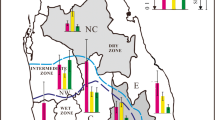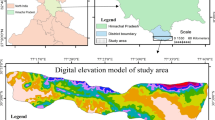Abstract
The study was intended to investigate heavy metal contamination levels in the rice grown in the vicinity of the mining areas of Singhbhum Copper Belt, India. The concentrations of the metals were below the Indian maximum allowable concentrations for food except for Pb, Ni, and Zn at some locations. Principal component analysis extracted three factors explaining 79.1% of the data variability. The extracted factors suggested that the sources of metals in the rice can be attributed to soil, irrigating water, and atmospheric dust deposition. High potential health risks of metal exposure from rice consumption were illustrated based on estimated daily intake (EDI) and target hazard quotient (THQ). The daily intakes of heavy metals for local adults were higher than the tolerable daily intakes provided by WHO in some samples for Cr, Fe, Ni, and V. Considering the geometric mean of the metals in rice samples of the study area, the hazard index (HI) for adult was above unity (3.09). Pb, Cu, and Cr were the key components contributing to potential non-carcinogenic risk. The HI varied from 2.24 to 12.7 among the locations indicating an appreciable heath risk to the consumers of the locally grown rice around the mining areas.


Similar content being viewed by others
References
Abbas ST, Sarfraz M, Mehdi SM, Hassan G, Rehman O (2007) Trace elements accumulation in soil and rice plants irrigated with the contaminated water. Soil Tillage Res 94(2):503–509
Adams M, Zhao FJ, McGrath SP, Nicholson FA, Chambers BJ (2004) Predicting cadmium concentrations in wheat and barley grain using soil properties. J Environ Qual 33:532–541
Adriano DC (2001) Trace elements in terrestrial environments: biogeochemistry, bioavailability and risks of metals, Second edn. Springer-Verlag, Berlin
Al-Saleh I, Shinwari N (2001) Report on the levels of cadmium, lead, and mercury in imported rice grain samples. Biol Trace Elem Res 83:91–96
Awasthi SK (2000) Prevention of Food Adulteration Act No. 37 of, 1954 Central and State rules as amended for 1999. Ashoka Law House, New Delhi
Camazano MS, Martin MJS, Lorenzo LF (1994) Lead and cadmium in soils and vegetables from urban gardens of Salamanca (Spain). Sci Total Environ 146(147):163–168
Cao H, Chen J, Zhang J, Zhang H, Qiao L, Men Y (2010) Heavy metals in rice and garden vegetables and their potential health risks to inhabitants in the vicinity of an industrial zone in Jiangsu, China. J Environ Sci 22(11):1792–1799
Chary NS, Kamala CT, Raj DSS (2008) Assessing risk of heavy metals from consuming food grown on sewage irrigated soils and food chain transfer. Ecotox Environ Safe 69:513–524
Closs LG, Nichol I (1975) The role of factor and regression analysis in the interpretation of geochemical reconnaissance data. Can J Earth Sci 12(8):1316–1330
Dang HS, Jaiswal DD, Parameswaran M, Deodhar KP, Krishnamony S (1996) Age dependent physical and anatomical Indian data for application in internal dosimetry. Radiat Prot Dosim 63:217–222
Dudka S, Adriano DC (1997) Environmental impacts of metal ore mining and processing: a review. J Environ Qual 26:590–602
Fangmin C, Ningchun Z, Haiming X, Yi L, Wenfang Z, Zhiwei Z, Mingxue C (2006) Cadmium and lead contamination in japonica rice grains and its variation among the different locations in southeast China. Sci Total Environ 359:156–166
FAO (1985) Food and Agriculture Organization. Water quality for agriculture. Irrigation and Drainage Paper No. 29, Rev. 1. Rome, United Nations
FAO (2004) Food and Agriculture Organisation, FAOSTAT, FAO Statistical Databases. http://apps.fao.org/
Feng JF, Wang YX, Zhao J, Zhu LQ, Bian XM, Zhang WJ (2011) Source attributions of heavy metals in rice plant along highway in Eastern China. J Environ Sci 23(7):1158–1164
Forstner U, Wiltman GTW (1983) Metal pollution in aquatic environment. Springer, Berlin
Fu J, Zhou Q, Liu J, Liu W, Wang T, Zhang Q, Jiang G (2008) High levels of heavy metals in rice (Oryza sativa L.) from a typical E-waste recycling area in southeast China and its potential risk to human health. Chemosphere 71:1269–1275
Giri S, Singh AK (2016) Spatial distribution of metal(loid)s in groundwater of a mining dominated area: recognising metal(loid) sources and assessing carcinogenic and non-carcinogenic human health risk. Int J Environ Anal Chem 96:1313–1330
Grasmück D, Sholz RW (2005) Risk perception of heavy metal soil contamination by high-exposed and low-exposed inhabitants: the role of knowledge and emotional concerns. Risk Anal 25:611–622
Gupta U, Gupta S (1998) Trace element toxicity relationships to crop production and livestock and human health: implications for management. Commun Soil Sci Plant Anal 29:1491–1522
Hang X, Wang H, Zhou J, Ma C, Du C, Chen X (2009) Risk assessment of potentially toxic element pollution in soils and rice (Oryza sativa) in a typical area of the Yangtze River Delta. Environ Poll 157:2542–2549
Harrison RM, Chirgawi MB (1989) The assessment of air and soil as contributors of some trace metals to vegetable plants I. Use of a filtered air growth cabinet. Sci Total Environ 83:13–34
Hellström L, Persson B, Brudin L, Petersson Grawé K, Öborn I, Järup L (2007) Cadmium exposure pathways in a population living near a battery plant. Sci Total Environ 373:447–455
Huang G, Chen Z, Sun J (2014) Water quality assessment and hydrochemical characteristics of groundwater on the aspect of metals in an old town, Foshan, South China. J Earth Syst Sci 123(1):91–100
Jain SC, Mehta SC, Kumar B, Reddy AR, Nagaratnam A (1995) Formulation of the reference Indian adult: anatomical and physiological data. Health Phys 68:509–522
Järup L (2003) Hazards of heavy metal contamination. Brit Med Bull 68:167–182
JECFA (1999) Joint FAO/WHO Expert Committee on Food Additives,. Reports of the 53rd meeting of the Joint FAO/WHO Expert Committee on Food Additives, JECFA/53/TRS. Rome, Italy
JECFA (2003) Joint FAO/WHO Expert Committee on Food Additives, Summary and conclusions of the 61st meeting of the Joint FAO/WHO Expert Committee on Food Additives. JECFA/61/SC. Rome, Italy
Kachenko AG, Singh B (2006) Heavy metals contamination in vegetables grown in urban and metal smelter contaminated sites in Australia. Water Air Soil Pollut 169:101–123
Khan S, Cao Q, Zheng YM, Huang YZ, Zhu YG (2008) Health risks of heavy metals in contaminated soils and food crops irrigated with wastewater in Beijing, China. Environ Poll 152:686–692
Kolsi SH, Bouri S, Hachicha W, Dhia HB (2013) Implementation and evaluation of multivariate analysis for groundwater hydrochemistry assessment in arid environments: a case study of Hajeb Elyoun-Jelma, Central Tunisia. Environ Earth Sci 70:2215–2224
Lin HT, Wong SS, Li GC (2004) Heavy metal content of rice and shellfish in Taiwan. J Food Drug Anal 12(2):167–174
Liu HY, Probst A, Liao BH (2005) Metal contamination of soils and crops affected by the Chenzhou lead zinc mine spill (Hunan, China). Sci Total Environ 339:153–166
Liu J, Zhang X, Tran H, Wang D, Zhu Y (2011) Heavy metal contamination and risk assessment in water, paddy soil, and rice around an electroplating plant. Environ Sci Pollut Res 18:1623–1632
Liu Z, Zhang Q, Han T, Ding Y, Sun J, Wang F, Zhu C (2016) Heavy metal pollution in a soil-Rice system in the Yangtze River region of China. Int J Environ Res Public Health 13:63. doi:10.3390/ijerph13010063
McBride MB (2003) Toxic metals in sewage sludge-amended soils: has promotion of beneficial use discounted the risks? Adv Environ Res 8:5–19
McBride MB (2007) Trace metals and sulfur in soils and forage of a chronic wasting disease locus. Environ Chem 4:134–139
McLaughlin MJ, Parker DR, Clarke JM (1999) Metals and micronutrients-food safety issues. Field Crops Res 60:143–163
Miller JC, Miller JN (1989) Statistics for analytical chemistry, Second edn. Ellis, Horwood
Miller NJ, Miller JC (2000) Statistics and chemometrics for analytical chemistry, Fourth edn. NJ7 Pearson Education, Englewood Cliffs
Monika DP, Katarzyna SK (2004) Histopathological changes in the liver, kidneys, and testes of bank voles environmentally exposed to heavy metal emissions from the steelworks and zinc smelter in Poland. Environ Res 96:72–78
Nan Z, Zhao C, Li J, Chen F, Sun W (2002) Relations between soil properties and elected heavy metal concentrations in spring wheat (Triticum aestivum L.) grown in contaminated soils. Water Air Soil Pollut 133:205–213
Navarro MC, Perez-Sirvent C, Martinez-Sanchez MJ, Vidal J, Tovar PJ, Bech J (2008) Abandoned mine sites as a source of contamination by heavy metals: a case study in a semi-arid zone. J Geochem Explor 96:183–193
NSSO (2014) National Sample Survey Office, Household Consumption of various goods and services in India 2011–12, NSS 68th Round, Ministry of Statistics and Programme Implementation, Government of India
Oliver MA (1997) Soil and human health: a review. Eur J Soil Sci 48:573–592
Pandey J, Pandey U (2009) Accumulation of heavy metals in dietary vegetables and cultivated soil horizon in organic farming system in relation to atmospheric deposition in a seasonally dry tropical region of India. Environ Monit Assess 148:61–74
Preston MR, Chester R (1996) Chemistry and pollution of the marine environment. In: Harison RM (ed) Pollution: causes, effects and control, Third edn. Royal Society of Chemistry, UK, pp 26–51
Pruvot C, Douay F, Herve F, Waterlot C (2006) Heavy metals in soil, crops and grass as a source of human exposure in the former mining areas. J Soils Sediments 6:215–220
Radojevic M, Bashkin VN (1999) Practical environmental analysis. Royal Society of Chemistry, London
Rupert LH, Neil B, Scott DY, Neil MJC, Andrew MT, Ann MM et al (2004) Assessing potential risk of heavy metal exposure from consumption of home-produced vegetables by urban populations. Environ Health Perspect 112:215–221
Schuhmacher M, Domingo JL, Llobet JM, Corbella J (1993) Dietary intake of copper, chromium and zinc in Tarragona Province, Spain. Sci Total Environ 132:3–10
Sharma RK, Agrawal M, Marshall FM (2008) Heavy metal (Cu, Zn, Cd and Pb) contamination of vegetables in urban India: a case study in Varanasi. Environ Poll 154(2):254–263
Singh S, Kumar M (2006) Trace metal load of soil, water and vegetables in peri-urban Delhi. Environ Monit Assess 120:79–91
Singh AN, Zeng DH, Chen FS (2005) Heavy metal concentrations in redeveloping soil of mine spoil under plantations of certain native woody species in dry tropical environment, India. J Environ Sci 1:168–174
Singh A, Sharma RK, Agrawal M, Marshall FM (2010) Health risk assessment of heavy metals via dietary intake of foodstuffs from the wastewater irrigated site of a dry tropical area of India. Food Chem Toxicol 48:611–619
Singh J, Upadhyay SK, Pathak RK, Gupta V (2011) Accumulation of heavy metals in soil and paddy crop (Oryza sativa), irrigated with water of Ramgarh Lake, Gorakhpur, UP, India. Toxicol Environ Chem 93(3):462–473
Sipter E, Rózsa E, Gruiz K, Tátrai E, Morvai V (2008) Site-specific risk assessment in contaminated vegetable gardens. Chemosphere 71:1301–1307
Song B, Lei M, Chen T, Zheng YM, Xie YF, Li XY, Gao D (2009) Assessing the health risk of heavy metals in vegetables to the general population in Beijing, China. J Environ Sci (China) 21:1702–1709
Sridhara Chary N, Kamala CT, Samuel Suman RD (2008) Assessing risk of heavy metals from consuming food grown on sewage irrigated soils and food chain transfer. Ecotoxicol Environ Saf 69(3):513–524
Turekian KK, Wedepohl KH (1961) Distribution of the elements in some major units of the earth’s crust. Am Geol Soc Bull 72:175–182
USEPA (1996) United States Environmental Protection Agency, EPA Method 3052: microwave assisted acid digestion of siliceous and organically based matrices. U.S. Environmental Protection Agency, Office of Solid Waste and Emergency Response, U.S. Government Printing Office, Washington, USA
USEPA (2007) United States Environmental Protection Agency, Integrated Risk Information System database; Philadelphia PA; Washington, USA
USEPA (2011) United States Environmental Protection Agency, Risk-based concentration table, Washington, USA
Usero J, Gonzalez-Regalado E, Gracia I (1997) Trace metals in the bivalve mollusks Ruditapes decussates and Ruditapes philippinarum from the Atlantic Coast of southern Spain. Environ Int 23(3):291–298
Voutsa D, Grimanis A, Samara C (1996) Trace elements in vegetables grown in an industrial area in relation to soil and air particulate matter. Sci Total Environ 94:325–335
Wang Q, Cui Y, Liu X, Dong Y, Christie P (2003) Soil contamination and plant uptake of heavy metals at polluted sites in China. J Environ Sci Health, Part A 38(5):823–838
Wang XL, Sato T, Xing BS, Tao S (2005) Health risks of heavy metals to the general public in Tianjin, China via consumption of vegetables and fish. Sci Total Environ 350:28–37
Wayne RO (1990) A physical explanation of the lognormality of pollutant concentrations. J Air Waste Manag Assoc 40:1378–1383
WHO (2001) World Health Organization, Environmental health criteria 224: arsenic and arsenic compounds: chapter 5. Environment levels and human exposure, 2nd edn. Geneva
Wilbur SB, Hansen H, Pohl H, Colman J, McClure P (2004) Using the ATSDR guidance manual for the assessment of joint toxic action of chemical mixtures. Environ Toxicol Pharmacol 18:223–230
Yang QW, Shu WS, Qiu JW, Wang HB, Lan CY (2004) Lead in paddy soils and rice plants and its potential health risk around Lechang lead/zinc mine, Guangdong, China. Env Int 30(7):883–889
Yang QW, Lan CY, Wang HB, Zhuang P, Shu WS (2006) Cadmium in soil–rice system and health risk associated with the use of untreated mining wastewater for irrigation in Lechang. China Agri Water Manag 84:147–152
Yap DW, Adezrian J, Khairiah J, Ismail BS, Mahir RA (2009) The uptake of heavy metals by paddy plants (Oryza sativa) in Kota Marudu, Sabah, Malaysia. American-Eurasian J Agric Environ Sci 6(1):16–19
Yuan GL, Sun TH, Han P, Li J (2013) Environmental geochemical mapping and multivariate geostatistical analysis of heavy metals in topsoils of a closed steel smelter: Capital Iron & Steel Factory, Beijing, China. J Geochem Explor 130:15–21
Yuan GL, Wu HZ, Fu S, Han P, Lang XX (2014) Persistent organic pollutants (POPs) in the topsoil of typical urban renewal area in Beijing, China: status, sources and potential risk. J Geochem Explor 138:94–103
Zeng F, Ali S, Zhang H, Ouyang Y, Qiu B, Wu F, Zhang G (2011) The influence of pH and organic matter content in paddy soil on heavy metal availability and their uptake by rice plants. Environ Poll 159:84–91
Zheng N, Wang QC, Zhang XW, Zheng DM, Zhang ZS, Zhang SQ (2007) Population health risk due to dietary intake of heavy metals in the industrial area of Huludao City, China. Sci Total Environ 387:96–104
Zhuang P, McBride BB, Xia HP, Li NY, Li ZA (2009a) Health risk from heavy metals via consumption of food crops in the vicinity of Dabaoshan mine, South China. Sci Total Environ 407:1551–1561
Zhuang P, Zou B, Li NY, Li ZA (2009b) Heavy metal contamination in soils and food crops around Dabaoshan mine in Guangdong, China: implication for human health. Environ Geochem Health 31:707–715
Acknowledgements
The authors are grateful to the Department of Science and Technology, Government of India, for providing the necessary funding for the study under the DST-Young Scientist Scheme (Grant No. YSS/2015/001211). Also, the authors are thankful to the Director and Environment Assessment and Remediation Section (NREM), CSIR-Central Institute of Mining and Fuel Research, Dhanbad, for providing the necessary laboratory facilities and other logistic supports for the study.
Author information
Authors and Affiliations
Corresponding author
Ethics declarations
Conflict of interest
The authors declare that they have no conflict of interest.
Additional information
Responsible editor: Philippe Garrigues
Rights and permissions
About this article
Cite this article
Giri, S., Singh, A.K. Human health risk assessment due to dietary intake of heavy metals through rice in the mining areas of Singhbhum Copper Belt, India. Environ Sci Pollut Res 24, 14945–14956 (2017). https://doi.org/10.1007/s11356-017-9039-9
Received:
Accepted:
Published:
Issue Date:
DOI: https://doi.org/10.1007/s11356-017-9039-9




